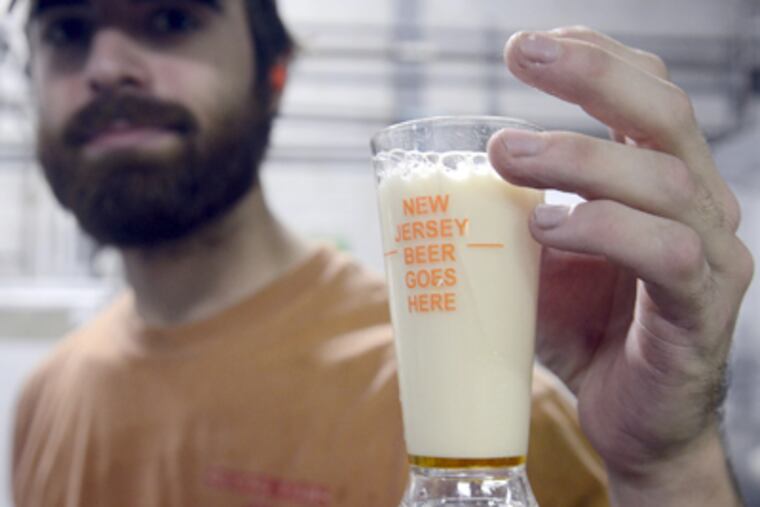Craft brewers plan major expansions to help meet demand
Small craft brewers have defied the nation's stubborn economic slump, unable to meet growing demand despite a pullback by consumers overall.

Small craft brewers have defied the nation's stubborn economic slump, unable to meet growing demand despite a pullback by consumers overall.
Several brewers in Pennsylvania and New Jersey are out to fix that supply problem by building new facilities, doubling and even tripling capacity to produce lagers and ales, and adding small numbers of jobs along the way.
Flying Fish Brewing Co. in Cherry Hill has paid $750,000 in deposits on equipment for a planned move to Somerdale that will triple its maximum capacity from the current 14,000 barrels a year.
Sly Fox Brewing Co. is planning to triple its current 10,000-barrel capacity when it moves from Royersford to Pottstown next year.
And last week, Tröegs Brewing Co., now in Harrisburg, was running tests at a new brewery in Hershey, Pa., that will double its capacity from 60,000 barrels, or 1.86 million gallons, a year from 30,000 barrels right out of the gate.
Echoing other brewery managers, Gene Muller, who founded Flying Fish in 1996 and is majority owner, said: "We're beyond our capacity. We're maxed out."
In the first half of this year, sales of craft beer, made by the country's 1,740 small breweries, climbed 14 percent, compared with a 9 percent gain in the first six months of 2010, according the Brewers Association, a trade group in Boulder, Colo.
"Things are definitely popping all over the country," said Paul Gatza, director of the association, whose Great American Beer Festival in Boulder starts Thursday. More than 400 breweries, including a strong contingent from the Philadelphia region, are expected to compete for gold medals.
Over the last five years, sales of craft beer - defined as the production of brewers with capacity of less than six million barrels per year - have climbed an average of 11 percent annually, Brewers Association data show.
By contrast, total domestic beer production was flat over the same period, according to the Beer Institute, a trade group in Washington.
Despite the gains by craft beer, it constituted just under 5 percent of total production last year. Big brewers such as the companies behind Budweiser, Miller, and Coors still account for about 82 percent of U.S. volume. Imports had a 13 percent market share last year.
Ironically, as craft-beer demand has grown, some of the brand sameness that predated the craft revival has begun to creep back, at least in Philadelphia.
Just about every bar claiming beer credibility seems to have on tap Bell's Two-Hearted Ale from Michigan, Stone India Pale Ale from San Diego, and Allagash White from Portland, Maine.
But that tide of ever-wider distribution might be turning.
This year, Dogfish Head Craft Brewery Inc. in Milton, Del., which had stormed across the country, decided to pull out of Tennessee, Indiana, Wisconsin, and Rhode Island because it could not meet demand in all the markets it entered.
Other brewers have made similar moves, Gatza said.
Mike Short, president of Hunterdon Brewing Co. in Phillipsburg, N.J., which distributes Sly Fox, Tröegs, and many other craft beers in that state, said his 20-member sales force has been less aggressive than it could be because of the supply shortage.
"Ten years ago, I used to go around to the stores almost begging them to take some of this stuff in," said Short, who started his company in 1996. "Now, I sit at my desk and get calls with people yelling at me because they can't get enough."
That is especially true with seasonal beers, such as Tröegs Mad Elf Ale, a popular Belgian dark ale available only during the last three months of the year.
"People want 25 to 50 cases, and we can deliver just three to five cases per account," Short said.
The new Tröegs brewery in Hershey, where visitors will be able to buy beer in the tasting room as well as take a self-guided tour, might help boost production of Mad Elf this year but "probably not as much as our wholesalers would like," brewery manager Ed Yashinsky said.
Tröegs, which employs close to 50 people full time and plans to add six to eight employees after the move, distributes in eight Northeastern states and has no immediate plans to enter new markets.
"The reality is, I think our business is based on the idea that we want to be regional. We'd rather be deep around here than be selling beer in Nebraska or Colorado," Yashinsky said.
Sly Fox now sells in Pennsylvania, New Jersey, and New York.
"Once we get our production up, we're probably going to enter Delaware, Maryland, and Virginia sometime in 2012," said John Giannopoulos, copresident of Sly Fox with his brother Pete.
In New Jersey, which has just 22 small brewers and brew pubs compared with 77 in Pennsylvania - largely because of regulations that are not as friendly to the business - Flying Fish's Muller looked at hundreds of buildings before choosing one in Somerdale.
Environmental tests have delayed the building purchase, but Muller, who employs 15 and plans to add eight after the move, has a backup in mind for his $4 million expansion.
"We have equipment being built for us in Germany, in Italy. We have equipment sitting in warehouses in Washington, South Carolina, and Connecticut, all waiting to be shipped to us. We just don't have any place to put it," he said. "The train has left the station. We're just not sure of the last stop."
For complete regional beer coverage, including the Joe Sixpack column, see www.philly.com/beer
EndText